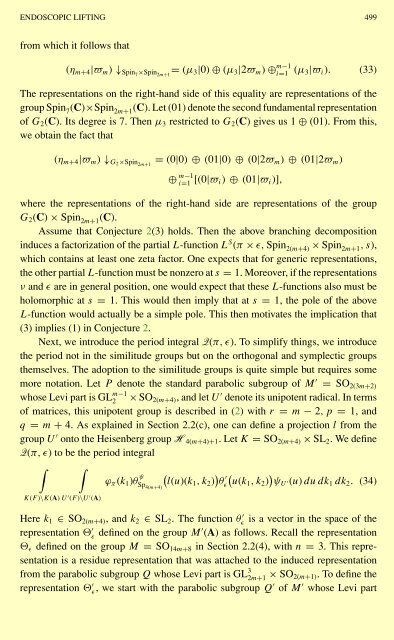A NULLSTELLENSATZ FOR AMOEBAS
A NULLSTELLENSATZ FOR AMOEBAS
A NULLSTELLENSATZ FOR AMOEBAS
Create successful ePaper yourself
Turn your PDF publications into a flip-book with our unique Google optimized e-Paper software.
ENDOSCOPIC LIFTING 499<br />
from which it follows that<br />
(η m+4 |ϖ m ) ↓ Spin7 ×Spin 2m+1<br />
= (µ 3 |0) ⊕ (µ 3 |2ϖ m ) ⊕ m−1<br />
i=1 (µ 3|ϖ i ). (33)<br />
The representations on the right-hand side of this equality are representations of the<br />
group Spin 7 (C)×Spin 2m+1 (C).Let(01) denote the second fundamental representation<br />
of G 2 (C). Its degree is 7. Then µ 3 restricted to G 2 (C) gives us 1 ⊕ (01). From this,<br />
we obtain the fact that<br />
(η m+4 |ϖ m ) ↓ G2 ×Spin 2m+1<br />
= (0|0) ⊕ (01|0) ⊕ (0|2ϖ m ) ⊕ (01|2ϖ m )<br />
⊕ m−1<br />
i=1 [(0|ϖ i) ⊕ (01|ϖ i )],<br />
where the representations of the right-hand side are representations of the group<br />
G 2 (C) × Spin 2m+1 (C).<br />
Assume that Conjecture 2(3) holds. Then the above branching decomposition<br />
induces a factorization of the partial L-function L S (π × ɛ, Spin 2(m+4) × Spin 2m+1 ,s),<br />
which contains at least one zeta factor. One expects that for generic representations,<br />
the other partial L-function must be nonzero at s = 1. Moreover, if the representations<br />
ν and ɛ are in general position, one would expect that these L-functions also must be<br />
holomorphic at s = 1. This would then imply that at s = 1, the pole of the above<br />
L-function would actually be a simple pole. This then motivates the implication that<br />
(3) implies (1) in Conjecture 2.<br />
Next, we introduce the period integral Q(π, ɛ). To simplify things, we introduce<br />
the period not in the similitude groups but on the orthogonal and symplectic groups<br />
themselves. The adoption to the similitude groups is quite simple but requires some<br />
more notation. Let P denote the standard parabolic subgroup of M ′ = SO 2(3m+2)<br />
whose Levi part is GL m−1<br />
2 × SO 2(m+4) ,andletU ′ denote its unipotent radical. In terms<br />
of matrices, this unipotent group is described in (2) with r = m − 2,p = 1, and<br />
q = m + 4. As explained in Section 2.2(c), one can define a projection l from the<br />
group U ′ onto the Heisenberg group H 4(m+4)+1 .LetK = SO 2(m+4) × SL 2 .Wedefine<br />
Q(π, ɛ) to be the period integral<br />
∫ ∫<br />
ϕ π (k 1 )θ ψ (<br />
Sp l(u)(k1<br />
4(m+4)<br />
,k 2 ) ) θ ɛ( ′ u(k1 ,k 2 ) ) ψ U ′(u) dudk 1 dk 2 . (34)<br />
K(F )\K(A) U ′ (F )\U ′ (A)<br />
Here k 1 ∈ SO 2(m+4) ,andk 2 ∈ SL 2 . The function θ<br />
ɛ ′ is a vector in the space of the<br />
representation ′ ɛ defined on the group M′ (A) as follows. Recall the representation<br />
ɛ defined on the group M = SO 14m+8 in Section 2.2(4), with n = 3. This representation<br />
is a residue representation that was attached to the induced representation<br />
from the parabolic subgroup Q whose Levi part is GL 3 2m+1 × SO 2(m+1).Todefinethe<br />
representation ′ ɛ , we start with the parabolic subgroup Q′ of M ′ whose Levi part
















